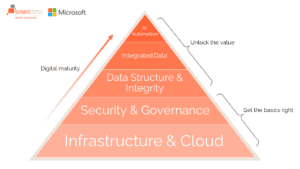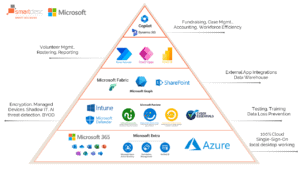In today’s digital age, charities need to continually adapt to leverage technology for greater impact. The digital maturity of a nonprofit plays a pivotal role in enhancing operational efficiencies, expanding reach, giving them a competitive edge and ultimately fulfilling its mission. In this blog, we explore the five key stages of digital maturity for nonprofit organisations and how you can reach them.
The Digital Maturity Pyramid
Achieving excellence in digital is a journey, not a sprint. To visualise this, we created a hierarchy with Microsoft Tech for Social Impact, illustrating the various layers you need to have in place to give your IT & Digital Strategy the best chance of success.

Organisations that can gain real value from data insight, AI and automation, have successfully implemented the prerequisite foundations. Without cloud infrastructure, good security, and well organised integrated data; AI, automation and insightful data will remain out of reach.
1) Infrastructure & Cloud: consolidate and optimise
A solid foundation is crucial for any digital transformation journey. Start by simplifying your infrastructure and make the most of Microsoft 365’s modern management tools like Intune to manage devices, Autopilot to automate deployment of new laptops, Entra for single sign on, Defender for 365 for security, and Azure to host legacy apps in the cloud until they move to full Software as a Service (SaaS) apps, accessed via the web browser.
By combining these with the skills of specialist providers for niche expertise such as hybrid IT support, cyber security specialists and IT Strategy experts, charities can reduce the complexity of their estate, and free up internal colleagues to add more valuable, business-focussed support. This IT infrastructure and IT support consolidation lays the groundwork for a more efficient and resilient digital environment which not only streamlines operations but also enhances the overall stability of your IT estate and makes it easier to manage and look after.
2) Governance & Security: secure data, tackle shadow IT
Charities deal with sensitive data, so it’s essential to have robust governance and security measures in place, especially if employees and volunteers are using multiple cloud apps and/or personal devices.
Governance of data in the cloud era can be complicated, so processes need to be in place to centralise procurement of systems and apps, ensure Data Protection Impact Assessments are undertaken, suppliers are vetted, systems are validated through Penetration or Vulnerability testing, users trained on good practice (especially around cyber security) and security evidenced through frameworks like Cyber Essentials.
Information Governance is a key workstream in this layer too; data retention and Data Loss Prevention (DLP) need consideration, and tools like Microsoft Purview now exist to simplify traditionally thorny tasks like Subject Access Requests and external audits.
Good security and governance gives the workforce the confidence to want to more with technology.
3) Data Structure & Integrity: getting AI Ready
As AI starts getting plugged into everything, it’s vital that the underlying data you hold is structured correctly, and permissions are in place to ensure people can only see the data they should be able to see. Not only to prevent data breaches or accidental disclosure of sensitive information, but also to ensure we can derive the maximum benefits from those AI tools to deliver the biggest impact in efficiency, insight and timesaving that they promise.
This layer involves assessing your data stores, structures, and systems to make sure they are structured in an optimal way. Restructuring data for the modern workplace, lays the foundations for future integrations and automation. In addition to structuring and cleansing data in M365 and file servers, line-of business apps such as HR, Finance and CRM should house well maintained and trusted data.
4) Integrated Data: becoming a data driven organisation
With our data well-structured and trusted, we unlock the ability to use it in a much more powerful way.
Integrating datasets from multiple systems can be achieved at a small scale with tools available in Microsoft Power Platform (part of M365), larger organisations may implement a Data Warehouse or Data Lake, and use data management toolsets such as Microsoft Fabric to bring datasets together.
Interrogating and reporting on integrated datasets, that were once siloed and separate, allows organisations to start making insight led decisions.
It also unlocks the true potential of AI and automation technologies.
5) AI & Automation: elevating your work
The way we work is about to change forever.
Generative AI is being built into all our everyday work applications. It will be adopted by us all; the only difference will be how quickly we benefit from its true value.
Organisations that do not have an AI strategy will get left further and further behind the competition.
Organisations that have successfully delivered the infrastructure and data projects described in this article, will be “AI ready” and can train their workforce in how to get the most from the technology.
Tasks that previously took hours of manual work will now be done in minutes; onboarding volunteers, spinning up new campaigns or events, generating marketing content, producing reports for the Board or Trustees, collaborating with other charities on projects, even running services in the field driven by mobile apps that you’ve created at speed and at very low cost. All this is possible using tools like Microsoft 365, Microsoft Power Platform and Microsoft Copilot. The quality of the outputs and the speed of production will be dependant on the robust infrastructure and data foundations that have been put in place.
The Microsoft nonprofit cloud
Most of the technical functionality described in this hierarchy can be achieved within the Microsoft ecosystem, which comes with significant cost savings for charities. The diagram below overlays the hierarchy with the corresponding Microsoft toolsets:

Where do I start?
Digital maturity is not a destination but a continuous journey for charities. Many of the charities we speak to have parts of the hierarchy in place, but the key to success is looking at each layer in detail, from the bottom up, to fill in the gaps to unlock the benefits of the next.
At Smartdesc, we help charities move forward strategically; from providing IT Leadership as a Service and independent Strategic Assessments, to delivering Programme & Change Management. From augmenting your internal IT capabilities via hybrid IT outsourcing partnerships, to offering Information Governance & Data Protection support and Chief Security Officer as a Service.
We are here to accelerate your technology strategy, plug the skills and resource gaps, and speed up your own digital maturity journey. Book your free consultation here or watch our video here to learn how we’ve been helping Mind on this same journey.
